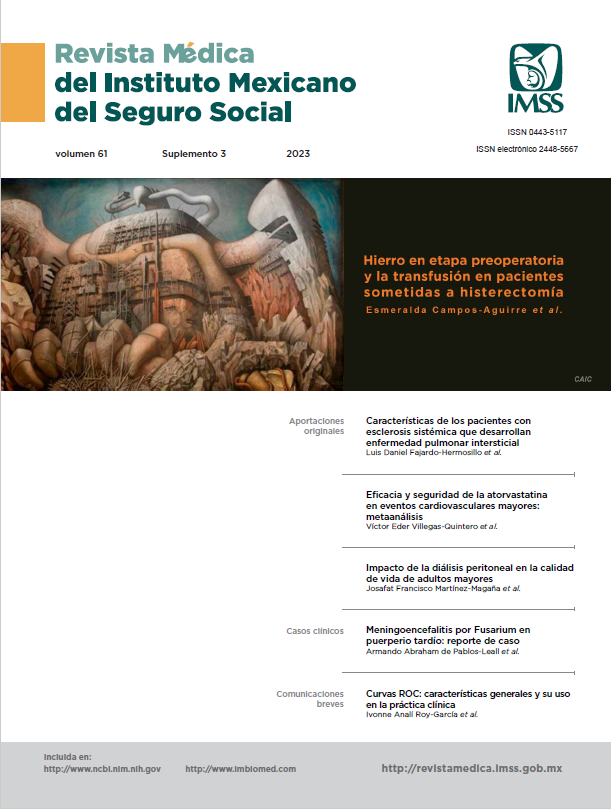Fusarium meningoencephalitis in the late puerperium: A case report
Main Article Content
Keywords
Central Nervous System Infections, Postpartum period, Fusarium
Abstract
Background: Fusarium infection in the central nervous system is a rare pathology generally reported in patients with hematological malignancies.
Clincal case: A patient with Fusarium meningoencephalitis during the late postpartum period is presented. The patient’s main symptom was holocranial headache with poor response to analgesics, adding dysarthria and blurred vision. Initially, it was classified as aseptic meningitis due to the absence of bacterial isolation, however, 8 weeks after the onset of the symptoms, Fusarium development was obtained in cerebrospinal fluid cultures. Targeted treatment with liposomal amphotericin and voriconazole was established, with partial improvement at first; however, at 16 weeks from the onset of the clinical picture, the patient presented sudden deterioration of alertness, an ischemic area was found in the occipital lobe by imaging study, which quickly led the patient to a fatal outcome.
Conclusion: Despite the fact that in recent years Fusarium spp. infection has been detected more frequently in the population, the treatment is still not well established, making management of the central nervous system a challenge.
References
Van Diepeningen AD, Brankovics B, Iltes J, Van der Lee TA, Waalwijk C. Diagnosis of Fusarium infections: approaches to identification by the clinical mycology laboratory. Current Fungal Infection Reports. 2015;9:135-43.
Alavi-Darazam I, Sharifi G, Jamali E, Khodavaisy S, Javandoust Gharehbagh F, Hakamifard A. Meningoencephalitis caused by Fusarium proliferatum: an unusual case. Infection. 2022:1-5.
Garcia RR, Min Z, Narasimhan S, Bhanot N. Fusarium brain abscess: case report and literature review. Mycoses. 2015; 58(1):22-6.
Karthigeyan M, Singh K, Kaur H, Salunke P, Pandey J, Nallasamy K. Multiple Fusarium brain abscesses in a young child. Child›s Nervous System. 2022;38(5):1017-21.
Góralska K, Blaszkowska J, Dzikowiec M. Neuroinfections caused by fungi. Infection. 2018;46(4):443-59.
Batista BG, Antunes-de Chaves M, Reginatto P, Jaconi-Saraiva O, Meneghello-Fuentefria A. Human fusariosis: An emerging infection that is difficult to treat. Revista da Sociedade Brasileira de Medicina Tropical. 2020;53:e20200013.
Pemán J, Salavert M. Enfermedad fúngica invasora por Scedosporium, Fusarium y Mucor. Revista Iberoamericana de Micología. 2014;31(4):242-8.
Garnica M, Nucci M. Epidemiology of fusariosis. Current Fungal Infection Reports. 2013;7(4):301-5.
Nucci F, Nouer SA, Capone D, Anaissie E, Nucci M, editors. Fusariosis. Seminars in respiratory and critical care medicine; 2015: Thieme Medical Publishers.
Mount HR, Boyle SD. Aseptic and bacterial meningitis: evaluation, treatment, and prevention. American Family Physician. 2017;96(5):314-22.
Fernández-López D. Meningitis/encefalitis por tuberculosis, perfil epidemiologico, comorbilidad y secuelas en pacientes con el virus de inmunodeficiencia humana: Universidad de Guayaquil. Facultad de Ciencias Médicas. Escuela de Medicina; 2018.
Pormohammad A, Nasiri MJ, McHugh TD, Riahi SM, Bahr NC. A systematic review and meta-analysis of the diagnostic accuracy of nucleic acid amplification tests for tuberculous meningitis. Journal of clinical microbiology. 2019;57(6):e01113-18.
Wu E-L, Al-Heeti O, Hoff BM, Williams JL, Krueger KM, Santoiemma PP, et al., editors. Role of Therapeutic Drug Monitoring in the Treatment of Persistent Mycobacterium abscessus Central Nervous System Infection: A Case Report and Review of the Literature. Open forum infectious diseases; 2022: Oxford University Press.
Nau R, Sorgel F, Eiffert H. Penetration of drugs through the blood-cerebrospinal fluid/blood-brain barrier for treatment of central nervous system infections. Clinical Microbiology Reviews. 2010;23(4):858-83.
Bongomin F, Gago S, Oladele RO, Denning DW. Global and multi-national prevalence of fungal diseases—estimate precision. Journal of Fungi. 2017;3(4):57.
Smith RM, Schaefer MK, Kainer MA, Wise M, Finks J, Duwve J, et al. Fungal infections associated with contaminated methylprednisolone injections. New England Journal of Medicine. 2013;369(17):1598-609.
Fariñas MC, Fernández-Sampedro M, Armiñanzas C. Formas clínicas y tratamiento de las infecciones causadas por otros hongos filamentosos. Enfermedades Infecciosas y Microbiología Clínica. 2012;30(7):414-9.
Rodríguez-Grimaldo JE, M González G, M Montoya A. Fusarium: un fitopatógeno que amenaza la salud humana. Ciencia UANL. 2022;25(114).
Tupaki-Sreepurna A, Kindo AJ. Fusarium: The versatile pathogen. Indian Journal of Medical Microbiology. 2018;36(1):8-17.
Dignani M, Anaissie E. Human fusariosis. Clinical Microbiology and Infection. 2004;10:67-75.
Muhammed M, Carneiro H, Coleman J, Mylonakis E. The challenge of managing fusariosis. Virulence. 2011;2(2):91-6.
Duarte A, Panizo MM, Ferrara G, Lage L, Reviakina V, Dolande M. Susceptibilidad in vitro a cinco antifúngicos de aislamientos del Complejo Fusarium solani provenientes de úlceras corneales. Revista de la Sociedad Venezolana de Microbiología. 2014;34(2):75-80.
Fortún J. Actualización del Tratamiento en Infecciones Fúngicas. PONENCIAS RESÚMENES DE.17.
McCarthy M, Rosengart A, Schuetz AN, Kontoyiannis DP, Walsh TJ. Mold infections of the central nervous system. New England Journal of Medicine. 2014;371(2):150-60.


